The street below our third-floor balcony is a cacophony of bursts, pops, chatter, shrieks, and distant loudspeakers. When I crack open the window, the scent of wood smoke from cooking fires that line the street fills the room, along with a dramatic increase in the concussive power of the sporadic booms. The distinctive roar of a large helicopter sweeping low overhead adds to the surreal sonic landscape and my imagination soars with visions of the chaotic scene below. After all our careful research and travel planning, how have we managed to stumble into an unexpected war zone?
Well, actually it’s just Las Fallas – Valencia’s version of March madness!
When we made the decision to establish a home in this Mediterranean city on the east coast of Spain, we knew we would face many challenges. There is a reason most Americans never leave the familiar comforts of home, and we have asked each other a hundred times, “Are we crazy? Why are we doing this?” Why put ourselves through the daunting challenge of learning a foreign language in our late 60’s? What’s the point of struggling to understand and negotiate the labyrinthine bureaucracy necessary to achieve even the basics of banking, utilities, and housing. There seem to be an endless list of obstacles to acquiring furniture, mail delivery, or something as simple as a box of tissues. All of this was predictable, and we pretty much understood that it was what we signed up for. Then, along comes Las Fallas. This is another level altogether.
In the first months of living here, it began to take on a mythical status in our minds. As we explored the city, meeting new people, asking questions about what it’s like to live in Valencia, the topic kept coming up. Hushed warnings about the first three weeks in March. Apocalyptic descriptions of a city over the brink. Standing travel plans made each year to escape the horror. Now, it’s important to keep in mind that nearly all our fledgling relationships in Valencia are with expats, who, to generalize unforgivably, sometimes tend to be a bit fearful of other cultures and perspectives. So, with that in mind, we bravely vowed to face our fears and explore Las Fallas for ourselves, in the flesh, with full knowledge of the terrible risks involved. Afterall, we have nearly mastered the Spanish banking system. How bad can it be? So, we vowed to live through the full season of Las Fallas our first year in Valencia.
THE ORIGIN STORY
Las Fallas seems to be unique to Valencia. While many cultures have a festival or carnival to celebrate the return of spring, few to none do it by embracing fire as a motif. It seems to have originated in the Middle Ages. To lengthen their work day in the depths of winter, carpenters would assemble wood structures to hold torches and candles. As the daylight hours lengthened in the Spring, they would gather these now unnecessary constructions into a pile and burn them to celebrate the increasing hours of sunlight. Of course, it soon became a competition to see who could build the biggest bonfire. And, then someone got the bright idea of building a pile with an artistic flare or a satirical image, and we were off to the races. As with many such celebrations, the church began to see an opportunity and declared that the holiday for Saint Joseph, patron saint of carpenters, would be the ideal occasion for this annual burning. As things go, the whole thing became more elaborate, expansive, and consuming to a degree that is pretty hard to describe. But I’m going to try.
Let’s get one thing out of the way right now: from an American perspective what goes on in modern day Valencia in March each year is insanity, and the response of our expat friends is understandable. Even the Valencianos get a bit weary of the weeks long festival of gunpowder, processions, and revelry before it finally ends on March 19 in blazing madness. So, what exactly is this thing?
The foundation of the modern Fallas celebration are the Falleros, Valencians dedicated to the traditions of their art, music and pageantry. Essentially, from what I can deduce as an outsider, Falleros are organized into neighborhood social clubs known as Casals that serve their communities in many capacities, but really take center stage when the annual celebration of St. Joseph rolls around. Each Casal produces a Falla to celebrate the season, among many other activities. Fallas are the progeny of those early carpenter’s bonfires, except things have evolved. Today, thousands of hours and tens of thousands of dollars are expended to create Fallas that are enormous, beautiful, colorful, profane, satirical, comical, charming, and shocking. There are over 350 Casals in Valencia, and nearly all of them create some sort of a Falla. And on the night of March 19, in what is known as “La Crema”, these works of art – some towering four stories high – are completely burned to the ground. Wait . . . what? That’s right. An entire years’ worth of fund raising, planning, designing, building, and decorating is torched in spectacular bonfires all over the city. These fires are so intense that fire fighters are required to hose down the surrounding buildings to make certain the destruction is limited to the Falla. Crazy, right? But there’s more.
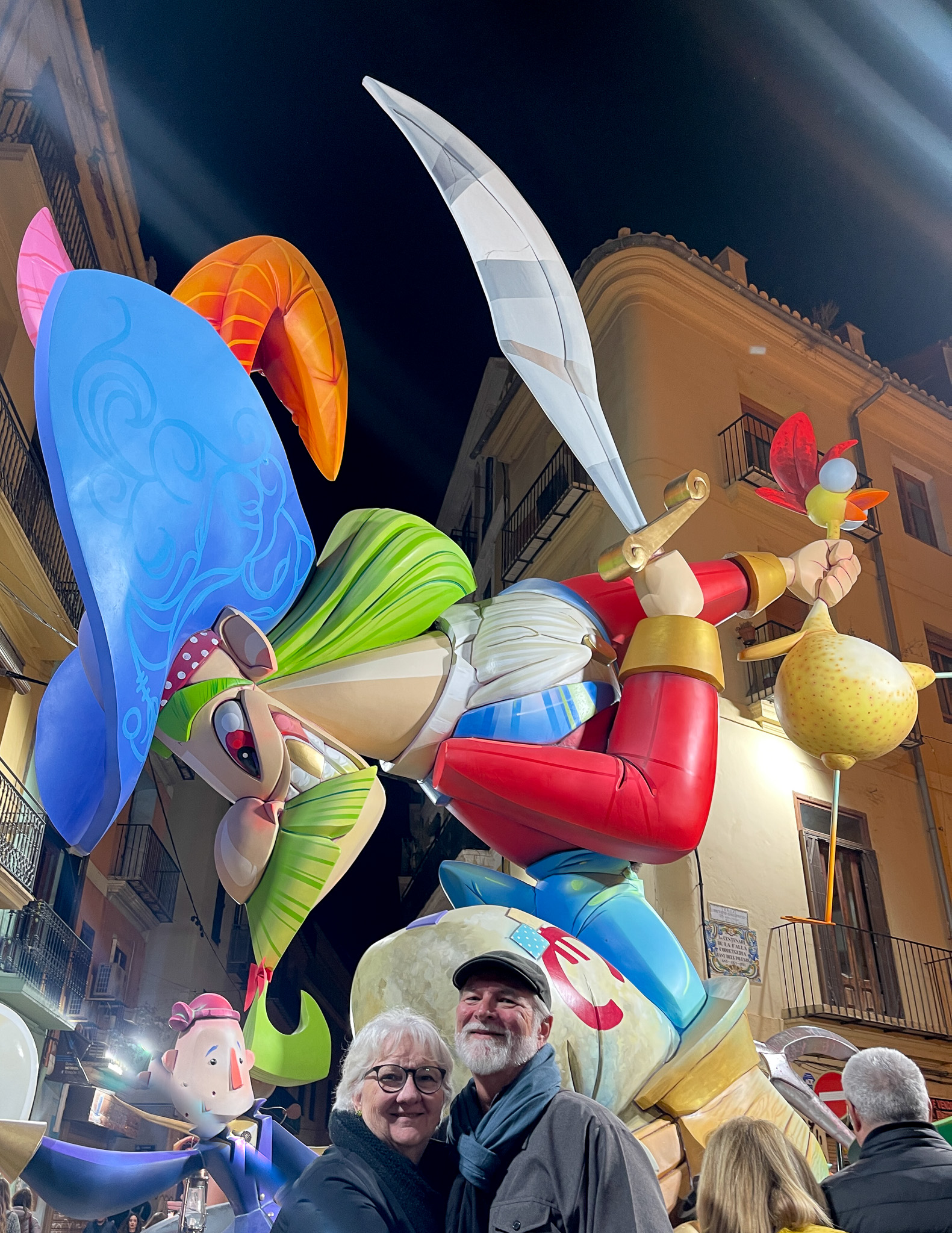
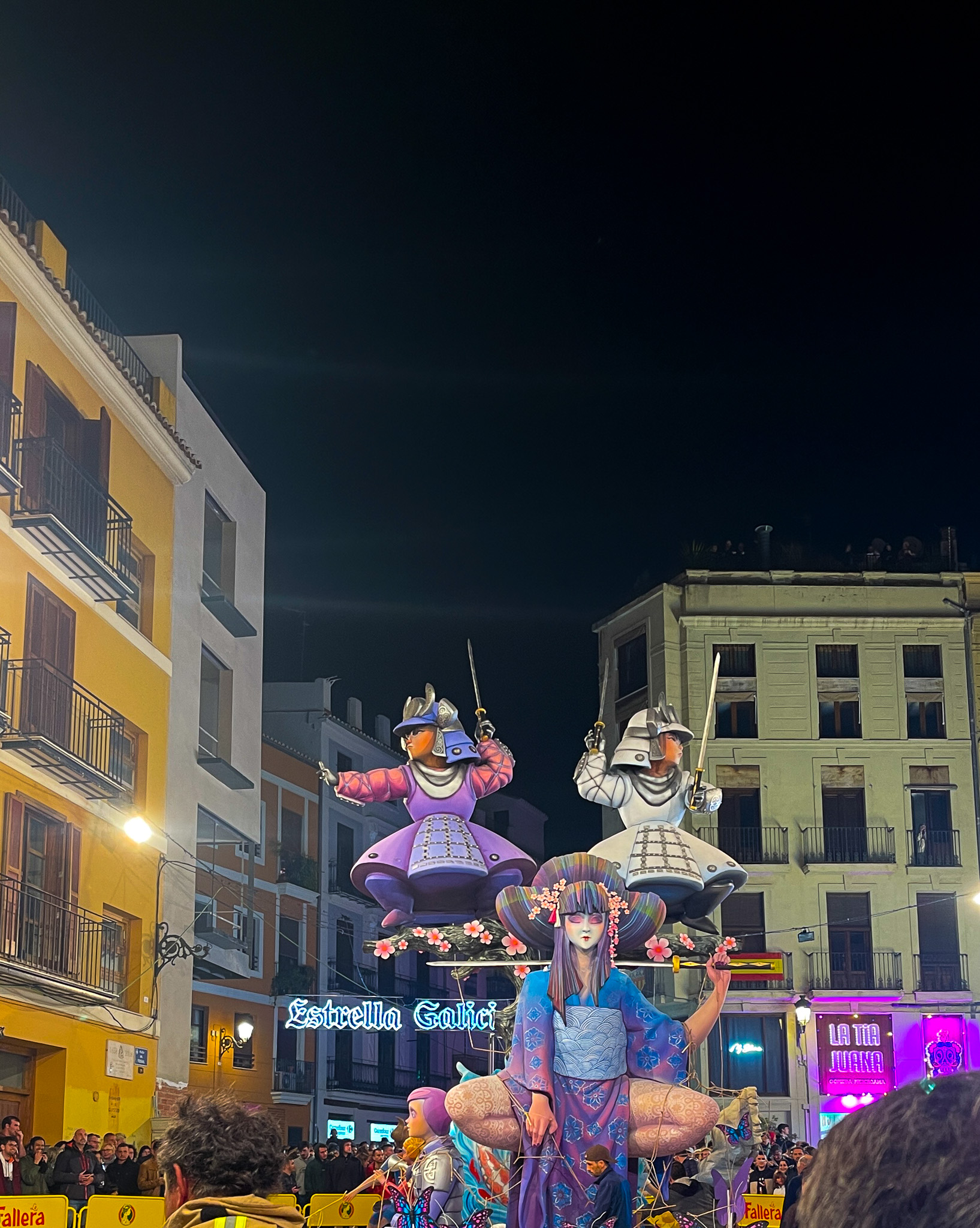
BOOM, BANG, POW . . .
Valencianos have a particular affection for gunpowder. Traditional fireworks displays are ubiquitous during the first 19 days in March. But what really gets your attention are the plain old firecrackers.
As a boy growing up in 1960’s California, firecrackers were illicit contraband. This, of course, made the use of them irresistible to an adolescent male who delighted in tormenting adults during the July 4th picnic each year. Each little matchstick size device was rationed to carefully husband the treasured collection for future mischief. In Valencia, on the other hand, every child seems to have acquired a cornucopia of explosives to be deployed at all hours of the day and night at a rate of expenditure that would have drained my meager childhood stash in a matter of minutes. And, far from being annoyed by this mayhem, the parents actually facilitate and encourage it!
For the most part, native Valencianos seem to be immune to the resulting chaos. Strolling through plazas in our area it’s common to see the local dogs out with their masters calmly napping in the sun while strings of firecrackers explode around them. On weekends, this cacophony begins just after breakfast and lasts until late into the night, punctuated every few minutes by the explosion of far more powerful charges handled by the local post puberty crews. People sitting at cafes around the city do not look up or appear startled by even the most shocking blasts. The whole ambient sound track is pretty hard for a foreigner to process, and frankly, it does become pretty tedious as the days stretch on. This, however, is merely the sonic merriment of amateurs. The ultimate expression of Valencianos passion for explosives is the Mascletá.
AFTERNOON DELIGHT . . . OR, MAYHEM?
Every day, from March 1 to March 19, in the middle of the huge Plaza that fronts the Valencia City Hall, crowds begin to gather just after noon, streaming to the plaza from all around the city. The balconies of all the surrounding buildings begin to fill with revelers and, as two o’clock approaches, the square is packed with merry Valencianos, eyes glistening with anticipation. At five minutes till two, a single explosion takes place to heighten the tension and signal that the countdown has begun. Restless murmurs begin to fill the plaza punctuated by shouts and cheers. Precisely at 2 pm, the fireworks begin. Rolling, thunderous explosions suddenly suck your breath away, smoke and ash fill the air, the crowd roars its approval, and the opening movement of the “symphony of gunpowder” has begun. The steady roar builds for a minute or two before giving way to a series of controlled breaks and thunderous explosions in a rhythmic staccato that comprises the second movement. The third section sees the bulk of the gunpowder expended in the movement known as “the earthquake”. The goal in this passage is to fill the city with overwhelming waves of sound. Each second that passes you’re sure that it cannot get louder, and then it does. The roar completely fills your consciousness and throbs through your body with such an all-consuming power that no other reality can intrude up until the moment when it suddenly ends, and the sonic force gripping your body and mind begins to relax. There is a startling moment of silence, and then the mass of humanity erupts in cheers and applause, ending one of the most intense five minutes of your life. Every day. For 19 days. Really.
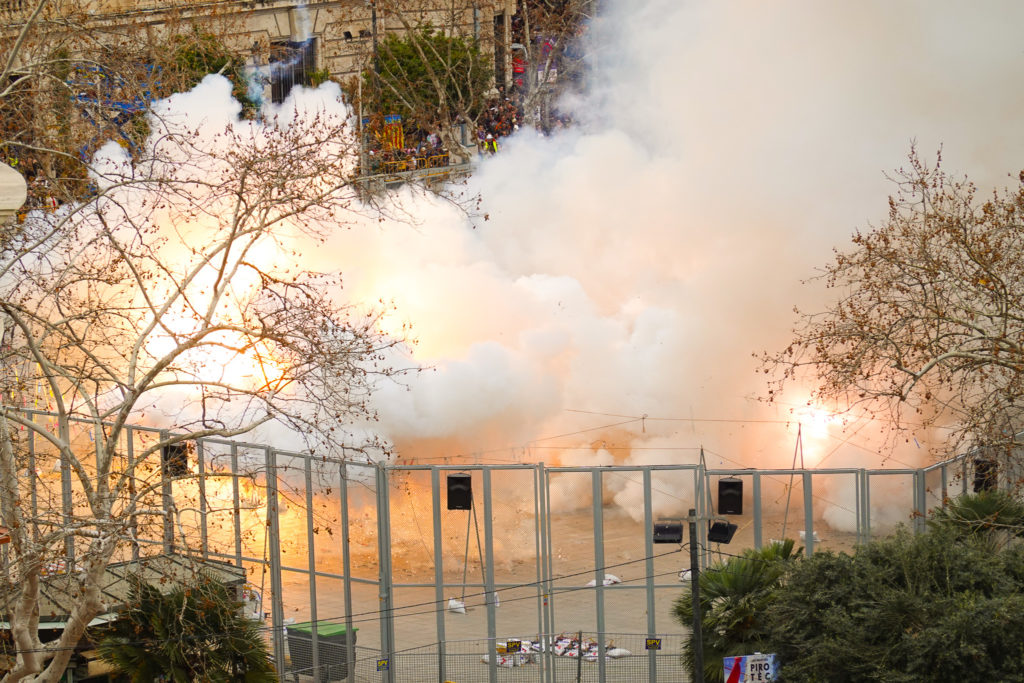
The Mascletá, like Las Fallas generally, seems to be unique to Valencia. And, while the first 19 days of March are the height of the practice, a Mascletá might be heard anytime of year to celebrate a wedding, the feast day of a saint, or just because it’s Tuesday afternoon. The authors of these performances are professional pyrotechnicians and local celebrities. Local newspapers print daily reviews of the artistic quality of the presentation and quotes from the author of the mayhem relative to his satisfaction or disappointment with the results. The practitioner judged to have created the best show is given the honor of being named to fire off the final Mascletá on March 19. These extraordinary practices – the Falla constructions, La Cremá, and Mascletá – are riveting, but there is much more going on during this festival. Many other aspects of the celebration seem to express the soul of what it means to be Valencian.
UPHOLDING TRADITION
As I mentioned earlier, the Casal – neighborhood communities of Falleros – are the heart of the celebration. It is these neighborhood groups that plan and fund raise all year in anticipation of the celebration of Saint Joseph. And it is the Casals that uphold and nurture the traditions of Valencia expressed in family, food, dress, music, and pageantry. It is at this level, the neighborhood gatherings to celebrate Las Fallas, where a more profound understanding of what this festival means to Valencia can be found.
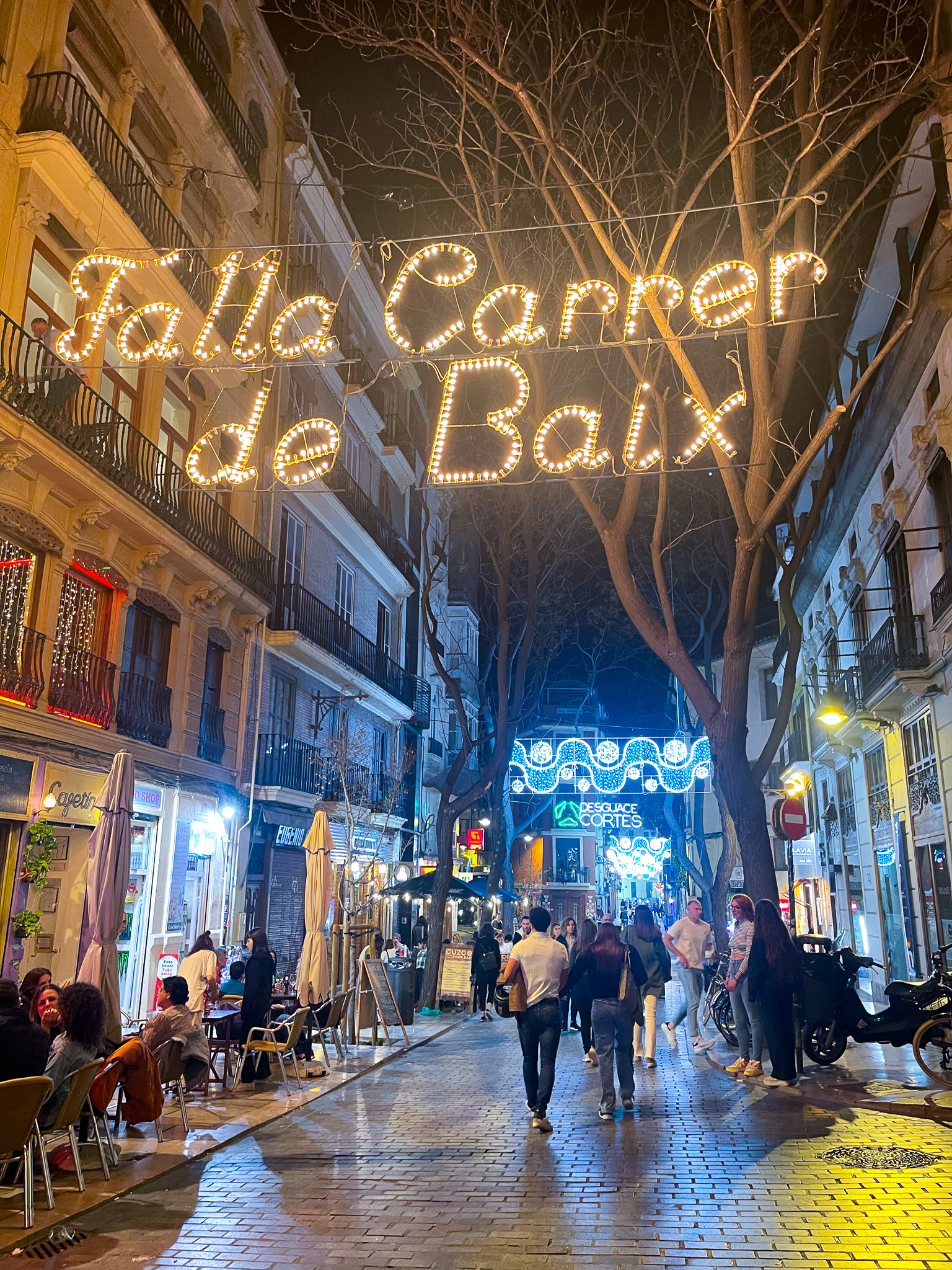
Everywhere you go around Valencia during Las Fallas you will find streets blocked with large party tents set up by the local Casal to facilitate the nightly gathering of the Falleros. These are whole family events where the community comes together to sing, dance, play music (everyone seems to play an instrument) and simply enjoy one another’s company. Among the most profound things we’ve observed is the embrace of the children by these communities. Growing up in a Valencia casal means knowing you are loved and cherished not just by your parents, but by dozens of generation spanning neighbors all passing down their legacy. Like everything in society, Casals come in all stripes and sizes – rich, poor, large, small, plain, and fancy. What they all have in common, however, is a sense of community beyond anything we have ever seen or experienced. They are at the heart of a particular lifestyle that seeks to honor and sustain the cultural history of Valencia.

One of the most charming traditions is the paella dinner. This world renown Spanish rice dish was created here in Valencia. The marshy mouth of the Turia river where it empties into the Mediteranean has been the site of rice cultivation since the Romans. Turning that rice into a flavorful, nutritious meal cooked over an open fire was, no doubt, originally born of necessity. Today, of course, it is a beloved part of the culture. Purists insist that only a paella prepared over a wood fire is authentic. And so, several times during Las Fallas, the falleros gather at their casal and build wood fires all along the street where traditional paella valenciana is prepared over an open flame. Like many things during Las Fallas, there is a good spirited competition among the cooks for the honor best paella, before everyone sits down to enjoy the feast.
OFFERINGS TO THE VIRGIN
Among the practices that we have come to cherish most is an event known as La Ofrenda (the offering). As practiced here in Valencia, the offering in question is one of flowers. The last week of the festival season, a three-story tall wood and steel version of the Virgin Mary is erected in the plaza adjacent to Valencia’s cathedral. With preparations complete, all the falleros and falleras meet at their casals in the traditional costume of the Valenciano – formal gowns fashioned from gorgeous, embroidered silks – to begin their procession from across the city to the Plaza of the Virgin. Each fallera carries in her arms a bouquet to be placed as an offering. This procession goes on pretty much continuously for two days with each group proudly marching behind their casal’s banner, accompanied by a traditional band marching with them. Tens of thousands take part, and by the end, the three-story effigy of the virgin has been completely covered in flowers. It’s a magnificent sight, and thankfully, not included in the final conflagration!
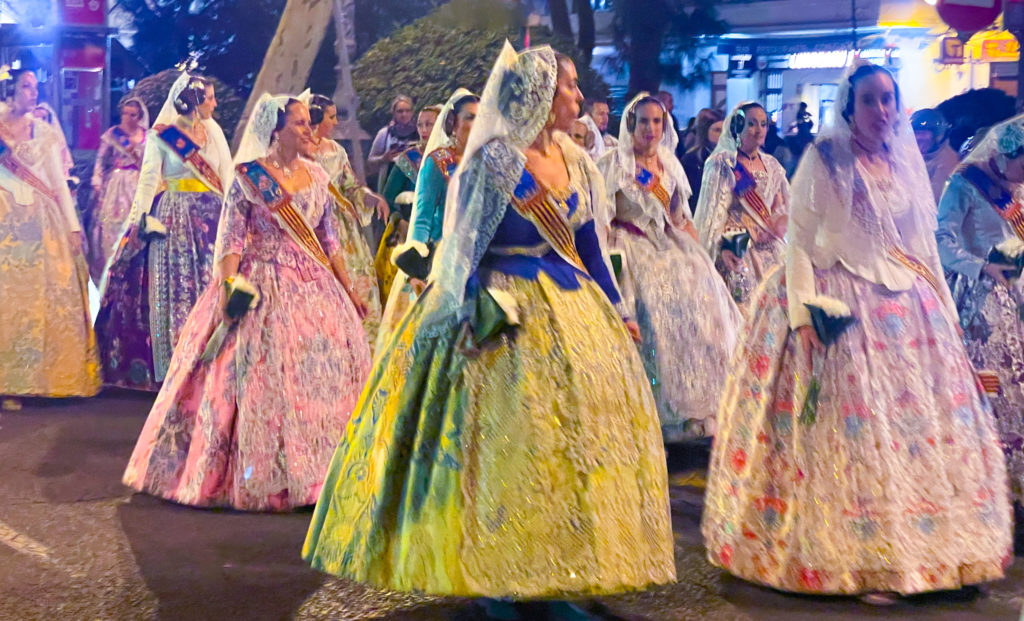
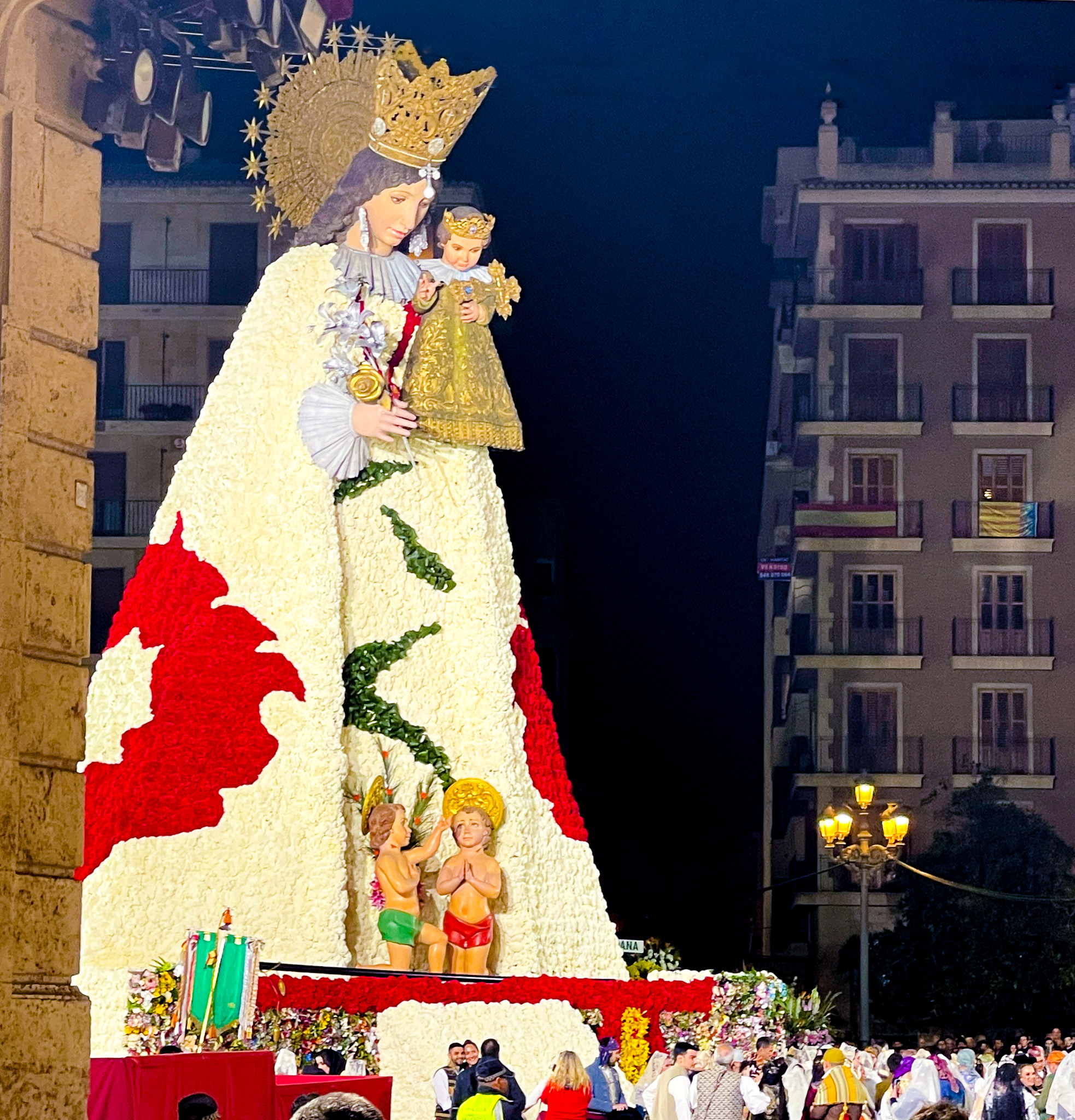
Another charming element of the festival is the display and judging of the Ninots, something we participated in this year for the first time. Ninots are individual figures that become elements of the larger fallas constructions described earlier. Like the final large fallas constructions, the ninots can be whimsical, satirical, lewd, inspiring, or despairing. They are all gathered for display in an exhibit hall for public viewing and judging. The ninot that wins the most votes receives a pardon from the night of fire and is retired to the Fallero Museum for posterity. The museum currently holds 80 year’s worth of winning ninot figures. When the judging is closed, all the ninots are moved onto the streets of Valencia to take their places in the assembly of the big fallas. Oh yeah, one other thing about these figures: each one includes a cavity stuffed with fireworks to ensure total destruction on the night of the crema.
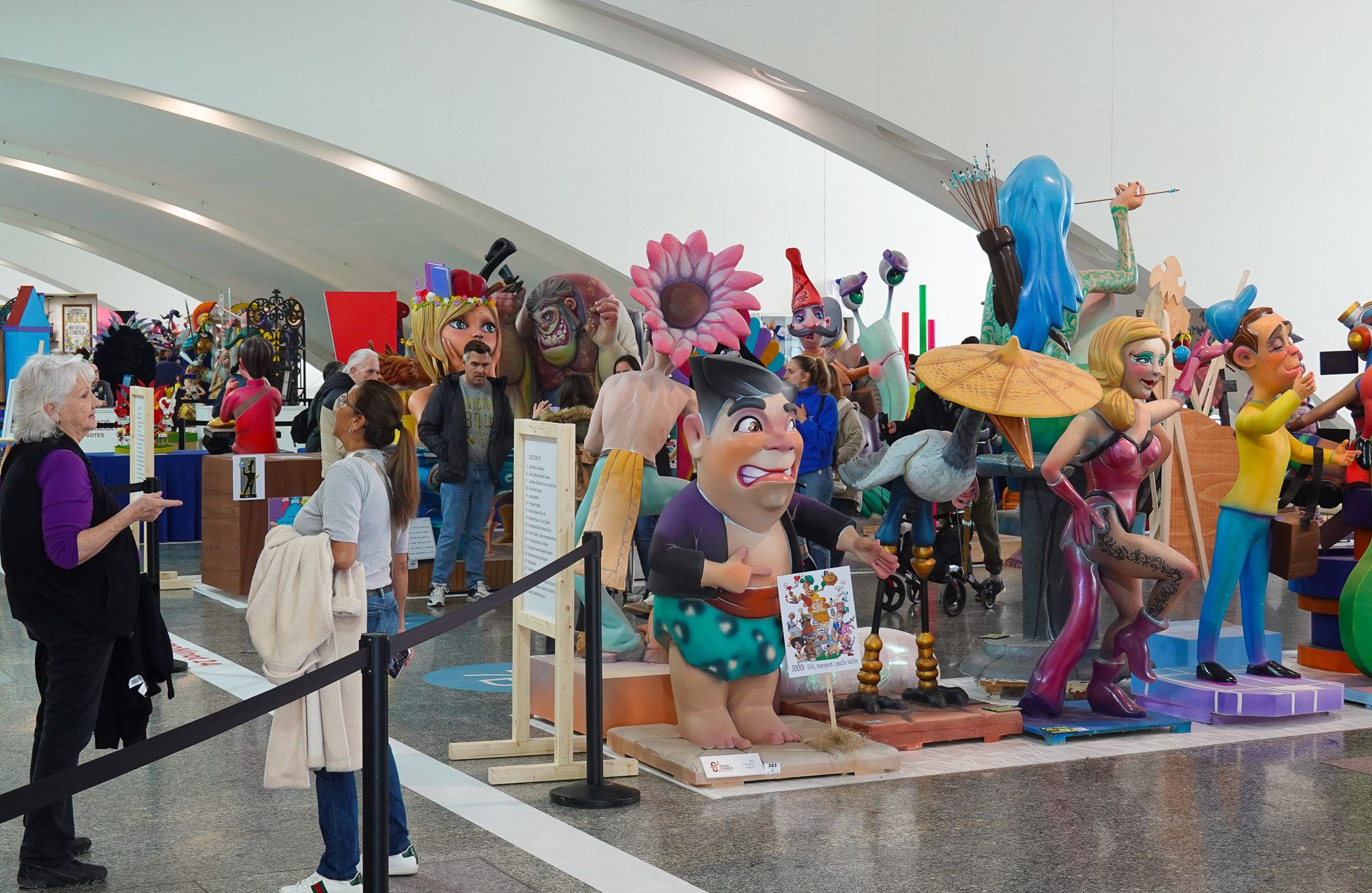
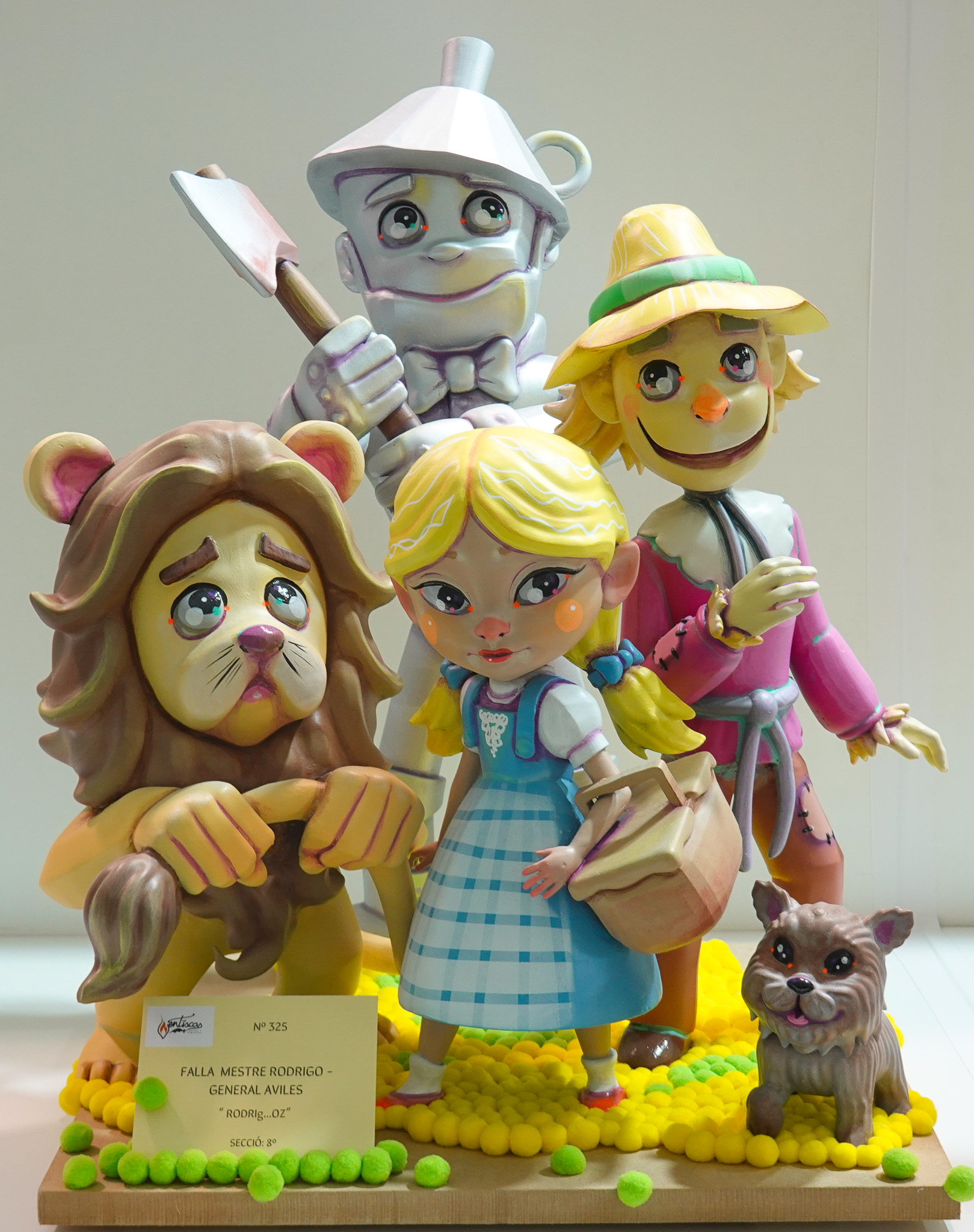
For 19 days, there are neighborhood street parties, live bands, trailers parked in every plaza to sell buñuelos, churros, and chocolate for dipping, firework displays, dance competitions, parades, marching bands, and tourists. Lots of tourists. Some estimates suggest that this city of 800,000 swells by more than 1,000,000 people from all over Europe during the last days of the festival. And, with the visitors comes much of the dark side of the festival. The locals Valencianos are rarely, if ever, drunk, or disrespectful. Often, however, the visitors are both. This leads, of course, to some ugliness as the level of debauchery builds toward the climactic night. And it is not hard to sympathize with our expat friends who flee the city for more peaceful destinations during Las Fallas. Our experience has certainly included some unpleasantness but not more than you might expect from a massive festival. As night falls on the 19th, a parade that celebrates fire moves through the city center, touching off a surreal landscape of explosions and conflagrations across the entire city.
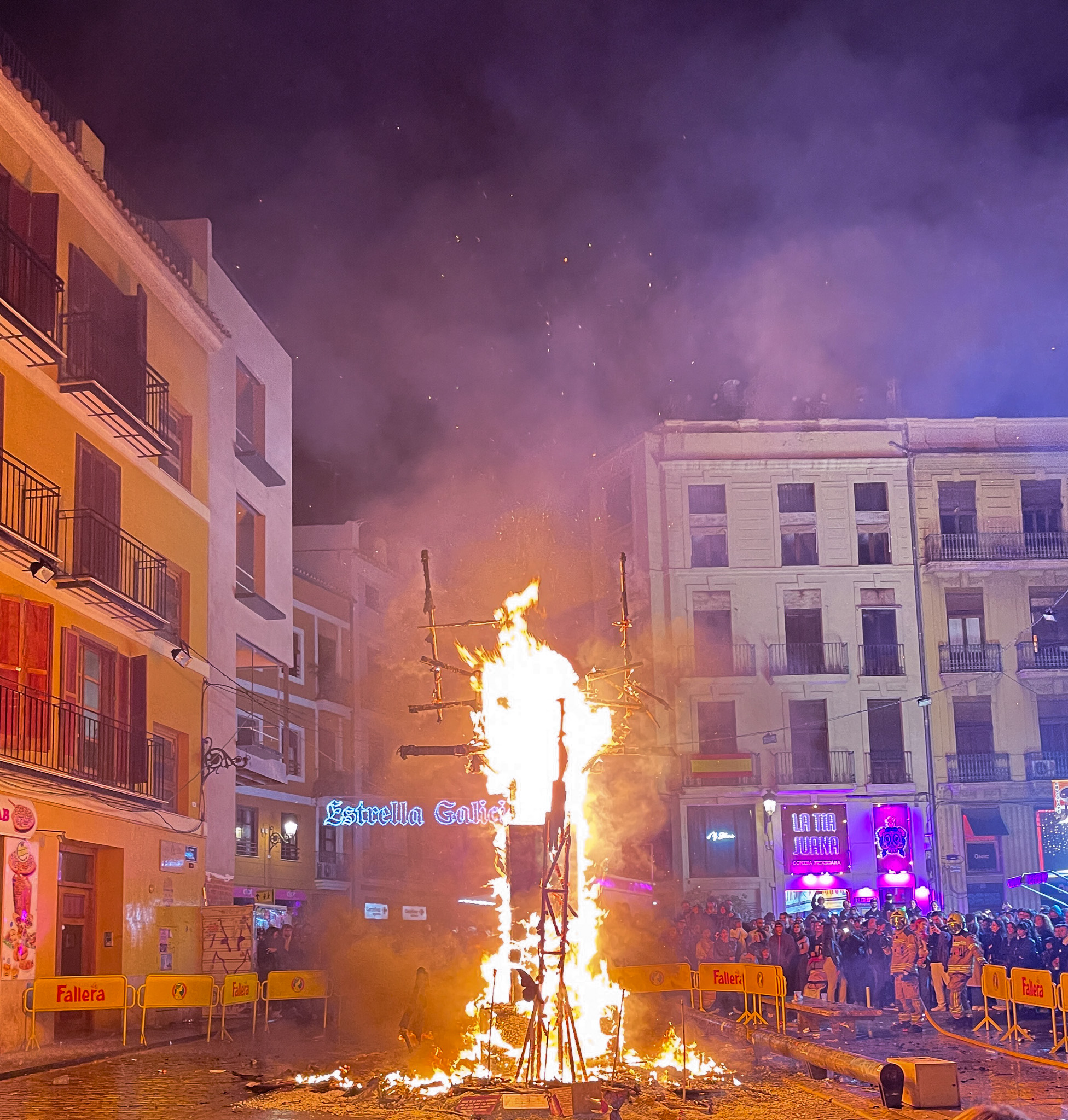
THE FINAL ACT
Then, as dawn breaks, one the most amazing aspects of Las Fallas is revealed. Overnight, an enormous army of city workers has been scouring the city. And while it will still be another day before the last vestiges have been removed, by late morning of the 20th, almost all evidence of the previous night’s chaos has been completely erased, the streets hosed down, the trash and litter removed, and the city returned to its routines as if nothing has happened.
This might be the most surreal moment of the entire festival.
NOTE:
You will find additional photos of Las Fallas in the Gallery. Also, I am attempting to write another post exploring what it all means. Still trying to get my head around it . . .
About Us
Welcome to our little corner of the world where we invite you to embark on exciting journeys with us!
We’re Ed and Bonnie, a duo passionate about exploring the world and experiencing its wonders. Our love for travel isn’t just about discovering new places; it’s about sharing those moments with cherished family and friends like you.
Our hope is that you will feel like you’re right there with us, sharing in the excitement and wonder of each destination. Better yet, let’s plan a rendezvous somewhere wonderful! Learn more

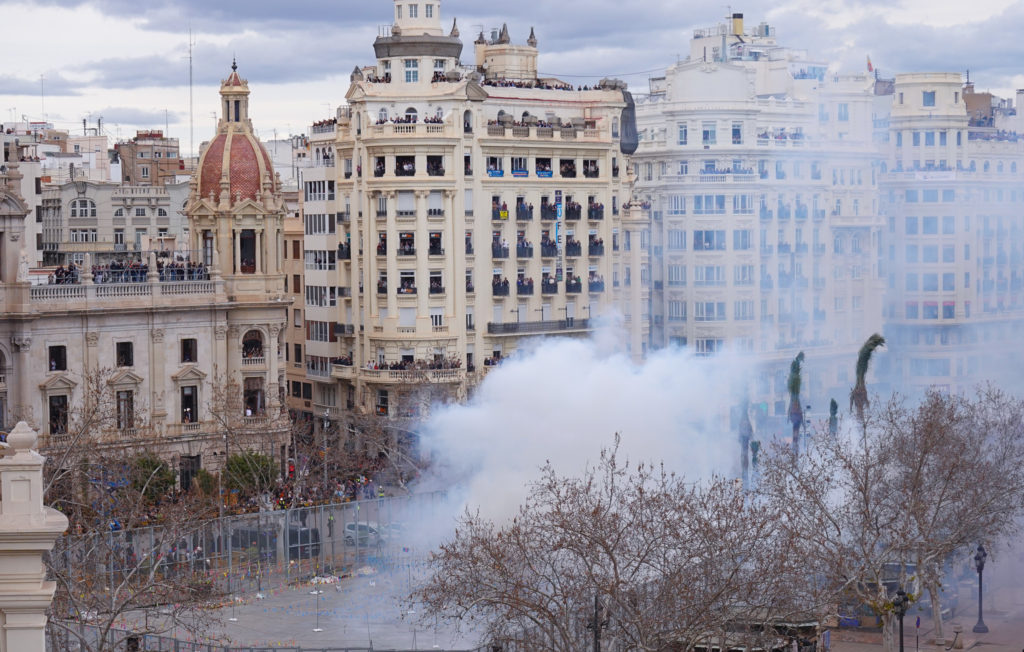
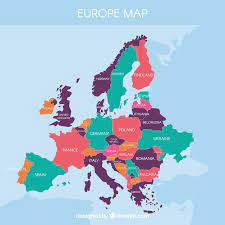
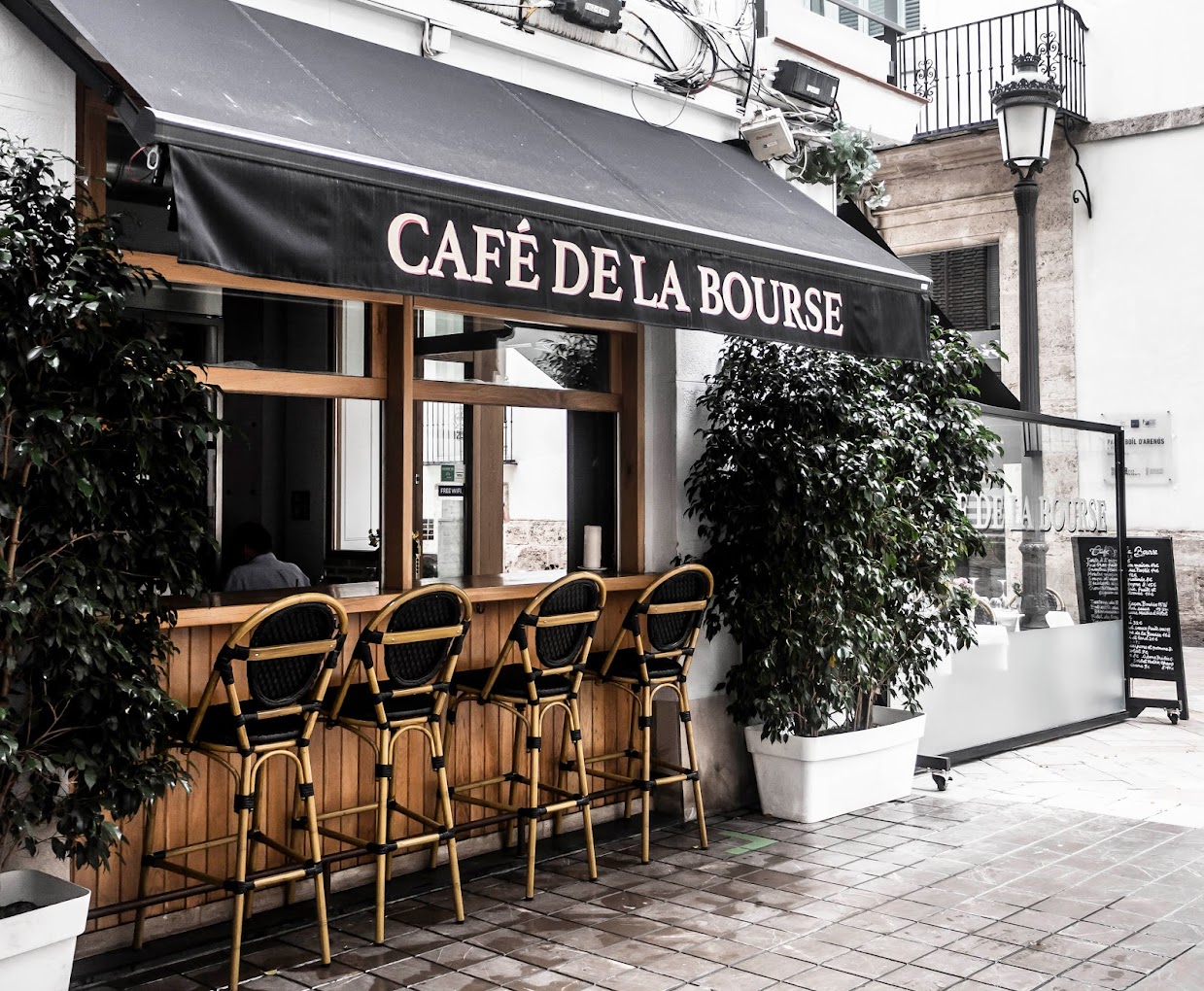
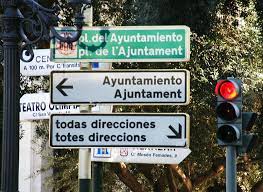
Absolutely Extraordinary!! Your amazing photos (Bonnie) And descriptive history of the FALLAS is masterful( (Ed). We almost feel like we have experienced the Wild Festival of Fire ourselves, but thankfully at a Distance! ( Nayan, as you may or may not know, absolutely Hates fireworks. It may harken back to a four year old childhood memory of watching a neighborhood house burn to the ground! Thus Fire, except for contained ones like a fireplace or small campfire, is Not her friend.). We love the Paella photo and didn’t know it originated in Valencia. And those Costumes are just exquisite. Italy also has Great Festivals but none of Fire that we know of. And then there is Sant Fe’s ZOZOBRA , a GIANT Air Born Figure that carries the Darkness of the Old Year and is Burned to welcome in the New One. We witnessed it on Christmas Eve in Santa F.e with the Derryberry’s on a snowy night as we all paraded up and down Canyon Road slipping into welcoming Galleries, drinking hot cider, with hundreds of Luminaras guiding our way: MAGICAL! Then back to the Derryberry Adobe for a simply delicious late supper of roast chicken and excellent wine. Memorable! Thanks for sharing this One of a Kind Festival Experience! Next come Italy and Greece: our Favorites! J&Nxo
I’ve always wanted to be in Santa Fe in the winter. I imagine soaking in a hot tub with snowflakes falling around me. We had a wonderful day today visiting one of Valencia’s casals and learning about about Fallas from a local. It was wonderful. We’re off to Italy in less than 48 hours!
Ed . . . What a wonderful account of Fallas! I learned a lot that I didn’t know and enjoyed reading about the things I did (or thought I did). Your writing is superb! Thanks for taking the time and making the effort. It is much appreciated.
Ed, what a historical and fun account of Las Fallas. Such adventures you two are on. Loved the photos and narration.
Reminds me of the Balinese holiday…Nyepi (also known as the “Day of silence”) takes place over a 6-day period but the day of silence falls on the 3rd day of the festival. On the eve before Nyepi day, the Balinese participate in the Ogoh-ogoh parade. Each village makes their own ogoh-ogoh statue, which is a large scary creature symbolising demons or monsters. The Ogoh-ogoh statues are carried through the island and at the end of the parade they are burnt – symbolising self-purification, ridding the island of evil spirits and cleansing the island in preparation for the New Year. The parades and Bonfires were spectacular.
Sending the two of you best wishes in Italy. Enjoy your travels.
Thanks, Suze. Another place to add to the list!
Pingback: Escape to Catalonia - Adventure BB